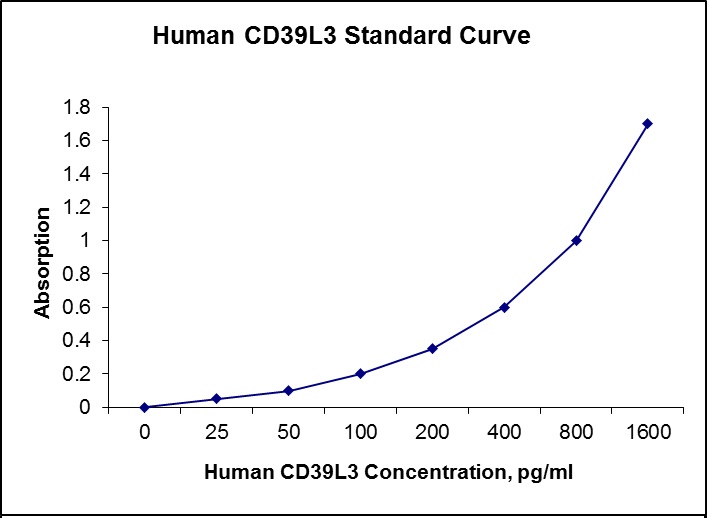Nori Human CD39L3/ENTPD3 ELISA Kit
$461.00 – $832.00
This ELISA kit is for quantification of CD39L3 in human. This is a quick ELISA assay that reduces time to 50% compared to the conventional method, and the entire assay only takes 3 hours. This assay employs the quantitative sandwich enzyme immunoassay technique and uses biotin-streptavidin chemistry to improve the performance of the assays. An antibody specific for CD39L3 has been pre-coated onto a microplate. Standards and samples are pipetted into the wells and any CD39L3 present is bound by the immobilized antibody. After washing away any unbound substances, a detection antibody specific for CD39L3 is added to the wells. Following wash to remove any unbound antibody reagent, a detection reagent is added. After intensive wash a substrate solution is added to the wells and color develops in proportion to the amount of CD39L3 bound in the initial step. The color development is stopped, and the intensity of the color is measured.
Alternative names for CD39L3: Cluster of Differentiation 39L3, Ectonucleoside triphosphate diphosphohydrolase 3 (ENTPD3)
This product is for Laboratory Research Use Only not for diagnostic and therapeutic purposes or any other purposes.
- Description
- How Elisa Works
- Product Citation (0)
- Reviews (0)
Description
Nori Human CD39L3 ELISA Kit Summary
Alternative names for CD39L3: Cluster of Differentiation 39L3, Ectonucleoside triphosphate diphosphohydrolase 3 (ENTPD3)
| Assay Type | Solid Phase Sandwich ELISA |
| Format | 96-well Microplate or 96-Well Strip Microplate |
| Method of Detection | Colorimetric |
| Number of Targets Detected | 1 |
| Target Antigen Accession Number | O75355 |
| Assay Length | 3 hours |
| Quantitative/Semiquantitative | Quantitative |
| Sample Type | Plasma, Serum, Cell Culture, Urine, Cell/Tissue Lysates, Synovial Fluid, BAL, |
| Recommended Sample Dilution (Plasma/Serum) | No dilution for sample <ULOQ; sufficient dilution for samples >ULOQ |
| Sensitivity | 5 pg/mL |
| Detection Range | 25-1600 pg/mL |
| Specificity | Natural and recombinant human CD39L3 |
| Cross-Reactivity | < 0.5% cross-reactivity observed with available related molecules, < 50% cross-species reactivity observed with species tested. |
| Interference | No significant interference observed with available related molecules |
| Storage/Stability | 4 ºC for up to 6 months |
| Usage | For Laboratory Research Use Only. Not for diagnostic or therapeutic use. |
| Additional Notes | The kit allows for use in multiple experiments. |
Standard Curve
Kit Components
1. Pre-coated 96-well Microplate
2. Biotinylated Detection Antibody
3. Streptavidin-HRP Conjugate
4. Lyophilized Standards
5. TMB One-Step Substrate
6. Stop Solution
7. 20 x PBS
8. Assay Buffer
Other Materials Required but not Provided:
1. Microplate Reader capable of measuring absorption at 450 nm
2. Log-log graph paper or computer and software for ELISA data analysis
3. Precision pipettes (1-1000 µl)
4. Multi-channel pipettes (300 µl)
5. Distilled or deionized water
Protocol Outline
1. Prepare all reagents, samples and standards as instructed in the datasheet.
2. Add 100 µl of Standard or samples to each well and incubate 1 h at RT.
3. Add 100 µl of Working Detection Antibody to each well and incubate 1 h at RT.
4. Add 100 µl of Working Streptavidin-HRP to each well and incubate 20 min at RT.
5. Add 100 µl of Substrate to each well and incubate 5-30 min at RT.
6. Add 50 µl of Stop Solution to each well and read at 450 nm immediately.
Background:
Ectonucleoside triphosphate diphosphohydrolase 3 (ENTPD3, also named CD39L3) is an enzyme that in humans is encoded by the ENTPD3 gene.[1] ENTPD3 is similar to E-type nucleotidases (NTPases). NTPases, such as CD39, mediate catabolism of extracellular nucleotides. ENTPD3 contains 4 apyrase-conserved regions which is characteristic of NTPases. Despite the increased level of NTPDase1 and NTPDase3 Mrna expression in chondrogenically induced MSCs, their activity toward ATP remains quite low.[2] NTPDase3 is the major ectonucleotidase in pancreatic beta-cells in multiple species and modulates insulin secretion by controlling activation of purinergic receptors.[3] Cystic fibrosis epithelia exhibit >50% lower NTPDase1 activity, protein, and mRNA levels than normal epithelia, whereas these parameters are threefold higher for NTPDase3.[4] Generation of a helical model for NTPDase3 suggests the importance of putative hydrogen bond interactions of conserved polar residues which are critical for enzyme expression, activity, and its susceptibility to membrane perturbations.[5]
References
- Chadwick BP, Frischauf AM (1998). Genomics. 50 (3): 357–67.
- Roszek K, et al. (2015) J. Cell. Biochem. 116 (12), 2915-2923.
- Syed SK, et a. (2013) Am. J. Physiol. Endocrinol. Metab. 305 (10), E1319-E1326.
- Fausther M, et al. (2010) Am. J. Physiol. Lung Cell Mol. Physiol. 298 (6), L804-L818.
- Gaddie KJ and Kirley TL. (2009) Biochemistry 48 (40), 9437-9447.
Be the first to review “Nori Human CD39L3/ENTPD3 ELISA Kit”
You must be logged in to post a review.




























Reviews
There are no reviews yet.